Nothing special here. It’s just a blog post for summarising my algorithm learning course. Although this was already taught in the University, it’s still god to summarize here
1. Symbol Tables
Key-value pair abstraction.
- Insert a value with specified key.
- Given a key, search for the corresponding value.
Example
| domain name | IP address |
|---|---|
| www.cs.princeton.edu | 128.112.136.11 |
| www.princeton.edu | 128.112.128.15 |
| www.yale.edu | 130.132.143.21 |
| www.harvard.edu | 128.103.060.55 |
| www.simpsons.com | 209.052.165.60 |
Symbol Table APIs
Symbol Tables act as an associative array, associate one value with each key.
public class ST<Key, Value> {
void put(Key key, Value, val);
Value get(Key key);
void delete(Key key);
boolean contains(Key key);
boolean isEmpty();
int size();
Iterable<Key> keys();
}2. Ordered Symbol Tables
If we order the keys in Symbol table, we can support a much wider number of operations, for example min, max operations and especially range operations.
| operations | keys | values |
|-------------------------------|----------|---------|
| min() ======================> | 09:00:00 | Chicago |
| | 09:00:03 | Phoenix |
| get(09:00:13) ==============> | 09:00:13 | Houston |
| | 09:00:59 | Chicago |
| | 09:01:10 | Houston |
| floor(09:05:00) ============> | 09:03:13 | Chicago |
| | 09:10:11 | Seattle |
| select(7) ==================> | 09:10:25 | Seattle |
| | 09:14:25 | Phoenix |
| ============================> | 09:19:32 | Chicago |
| ============================> | 09:19:46 | Chicago |
| keys(09:15:00, 09:25:00) ===> | 09:21:05 | Chicago |
| ============================> | 09:22:43 | Seattle |
| ============================> | 09:22:54 | Seattle |
| | 09:25:52 | Chicago |
| ceiling(09:30:00) ==========> | 09:35:21 | Chicago |
| | 09:36:14 | Seattle |
| max() ======================> | 09:37:44 | Phoenix |
| size(09:15:00, 09:25:00) = 5 | | |
| rank(09:10:25) = 7 | | |
Ordered Symbol Table APIs
public class ST<Key extends Comparable<Key>, Value> {
void put(Key key, Value val);
Value get(Key key);
void delete(Key key);
boolean contains(Key key);
boolean isEmpty();
Key min();
Key max();
Key floor(Key key);
Key ceiling(Key key);
int rank(Key key); // number of keys less than key
Key select(int k); // select key of rank k
void deleteMin();
void deleteMax();
// range operations
int size(); // size of the whole tree
int size(Key lo, Key hi); // size of range
Iterable<Key> keys(); // iterate through all keys
Iterable<Key> keys(Key lo, Key hi); // iterate though keys in range
}3. Binary Search Tress
Binary Search Tree is a binary tree in symmetric order. Each node has a key, and every node’s key is
- Larger than all keys in its left subtree.
- Smaller than all keys in its right subtree
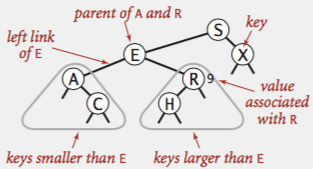
Using BST, we can implement all the operations of Ordered Symbol Tables quite efficiently, as long as keys are inserted in random order.
Node
A Binary Search Tree is a reference to the root Node
class Node {
private Key key;
private Value val;
private Node left, right;
public Node(Key key, Value val) {
this.key = key;
this.val = val;
}
}
Get method
Return value corresponding to given key, or null if no such key. Traverse from the root node, if less, go left, if greater, go right, if equal, search hit.
public Value get(Key key) {
Node x = root;
while (x != null) {
int cmp = key.compareTo(x.key);
if (cmp < 0) x = x.left;
else if (cmp > 0) x = x.right;
else if (cmp == 0) return x.val;
}
return null;
}
Insert method
Search for key, then two cases:
- Key in tree ⇒ reset value.
- Key not in tree ⇒ add new node.
private Node put(Node x, Key key, Value val) {
if (x == null) return new Node(key, val);
int cmp = key.compareTo(x.key);
if (cmp < 0)
x.left = put(x.left, key, val);
else if (cmp > 0)
x.right = put(x.right, key, val);
else if (cmp == 0)
x.val = val;
return x;
}
Floor/Ceiling method
Floor: Largest key ≤ a given key
- Case 1: k equals the key at root
- The floor of
kisk
- The floor of
- Case 2: k is less than the key at root
- The floor of
kis in the left subtree.
- The floor of
- Case 3: k is greater than the key at root
- The floor of
kis in the right subtree if there is any key ≤kin right subtree - Otherwise it is the key in the root.
- The floor of
private Node floor(Node x, Key key) {
if (x == null) return null;
int cmp = key.compareTo(x.key);
if (cmp == 0)
return x;
if (cmp < 0)
return floor(x.left, key);
Node t = floor(x.right, key);
if (t != null)
return t;
else
return x;
}
Ceiling: the reverse way
Subtree counts
In each node, we store the number of nodes in the subtree rooted at that node; To implement size(),
return the count at the root.
Rank. How many keys < k ?
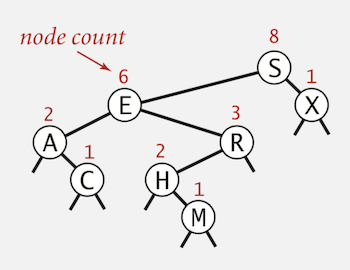
public int rank(Key key) {
return rank(key, root);
}
private int rank(Key key, Node x) {
if (x == null) return 0;
int cmp = key.compareTo(x.key);
if (cmp < 0)
return rank(key, x.left);
else if (cmp > 0)
return 1 + size(x.left) + rank(key, x.right);
else if (cmp == 0)
return size(x.left);
}
In-Order Traversal
- Traverse left subtree.
- Enqueue key.
- Traverse right subtree.
public Iterable<Key> keys() {
Queue<Key> q = new Queue<Key>();
inorder(root, q);
return q;
}
private void inorder(Node x, Queue<Key> q) {
if (x == null) return;
inorder(x.left, q);
q.enqueue(x.key);
inorder(x.right, q);
}
In-Order traversal of a BST yields keys in ascending order
Lazy Deletion
To remove a node with a given key:
- Set its value to null.
- Leave key in tree to guide search (but don’t consider it equal in search)
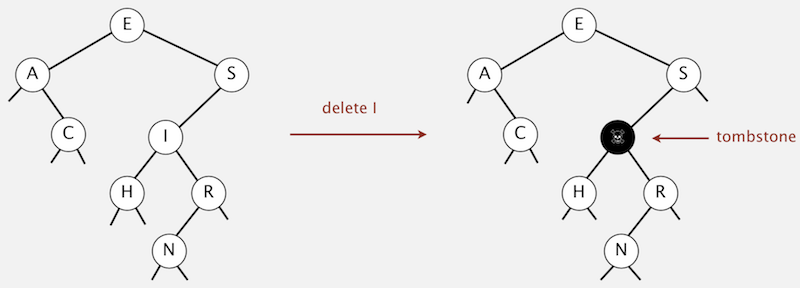
Drawback: Tombstone (memory) overload
Delete the minimum
To delete the minimum key:
- Go left until finding a node with a null left link.
- Replace that node by its right link.
- Update subtree counts.
public void deleteMin() {
root = deleteMin(root);
}
private Node deleteMin(Node x) {
if (x.left == null) return x.right;
x.left = deleteMin(x.left);
x.count = 1 + size(x.left) + size(x.right);
return x;
}
Delete a specific key using Hibbard deletion
To delete a node with key k: search for node t containing key k.
- Case 0:
0 childrenDelete t by setting parent link to null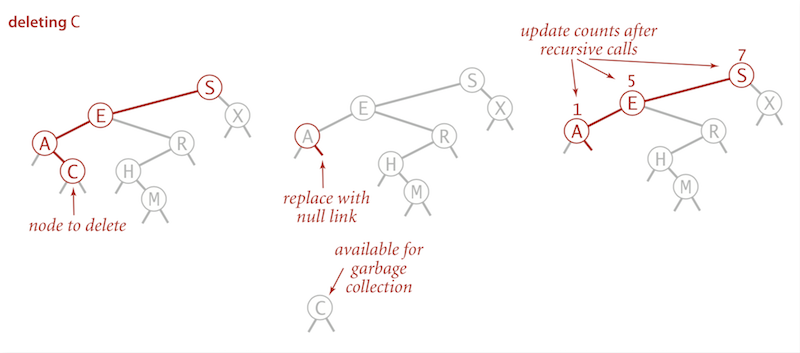
- Case 1:
1 childDelete t by replacing parent link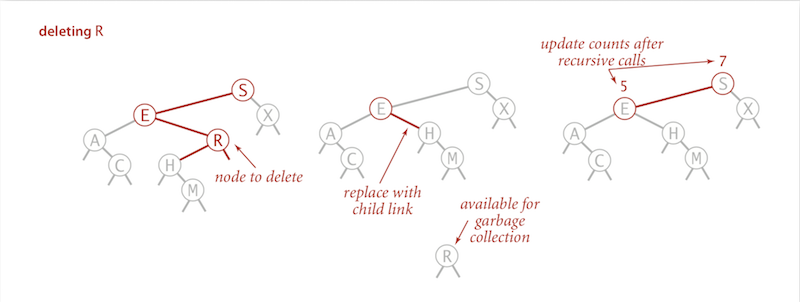
- Case 2:
2 children- Find successor
xoft, find thexwhich can replace the position of the nodet(the min oft.right). - Delete that node
xout of the BST using thedeleteMinmethod, but keep the nodexin memory. - Put
xint’s spot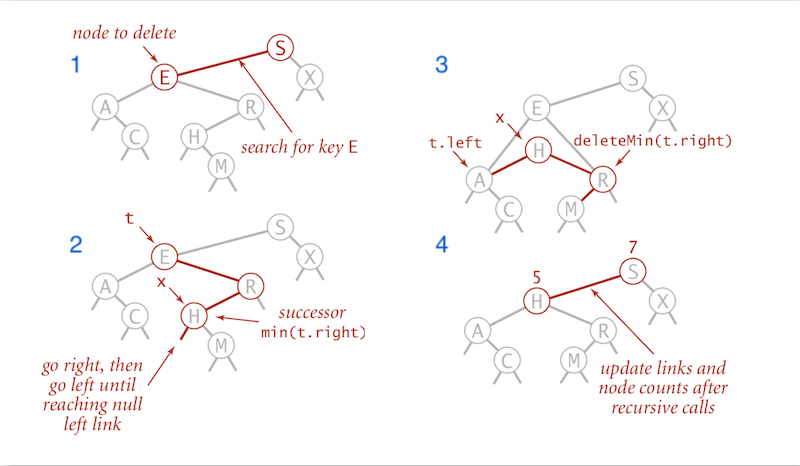
- Find successor
public void delete(Key key) {
root = delete(root, key);
}
// delete method returns the new tree after deletion
private Node delete(Node x, Key key) {
if (x == null) return null;
// search for key by traserving left/right
int cmp = key.compareTo(x.key);
if (cmp < 0)
// set the subtree to the new tree after deletion
x.left = delete(x.left, key);
else if (cmp > 0)
// set the subtree to the new tree after deletion
x.right = delete(x.right, key);
else {
// case 0 and case 1, return null or the left/right subtree to
// update the link in parent node
if (x.right == null) return x.left;
if (x.left == null) return x.right;
// case 2, replace with successor
Node t = x;
x = min(t.right);
x.right = deleteMin(t.right);
x.left = t.left;
}
// update subtree counts
x.count = size(x.left) + size(x.right) + 1;
return x;
}
